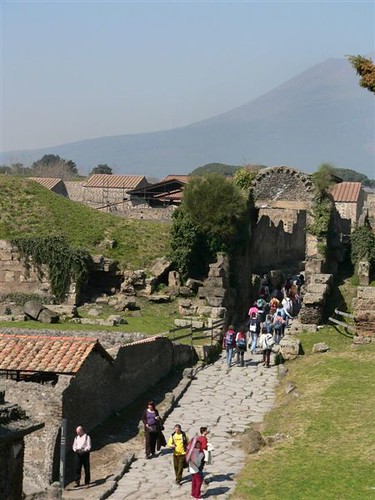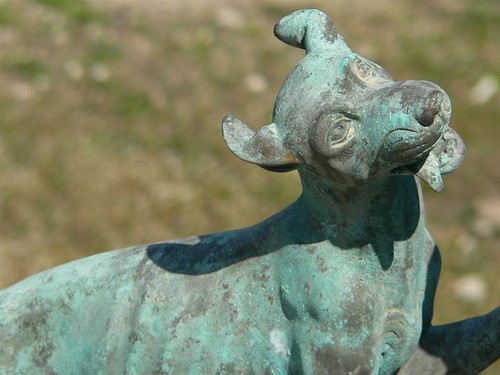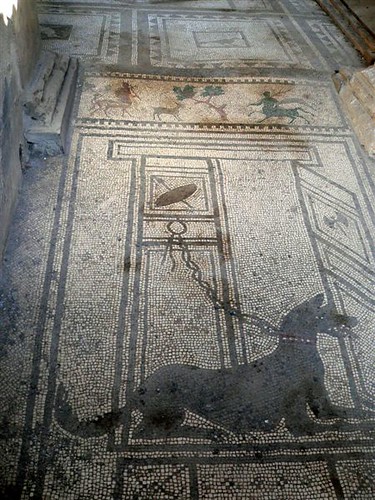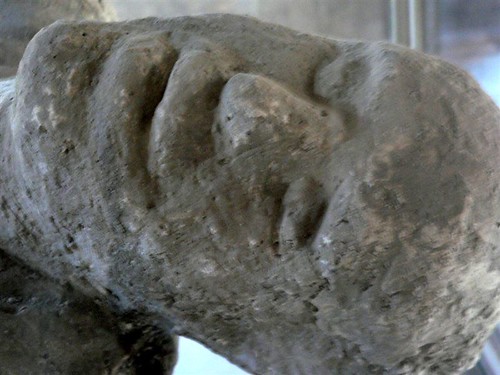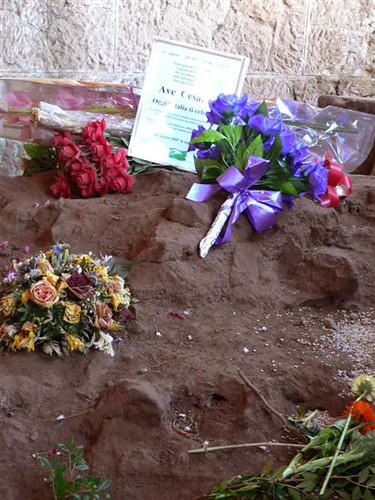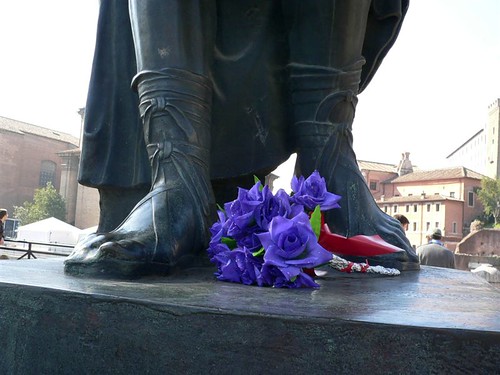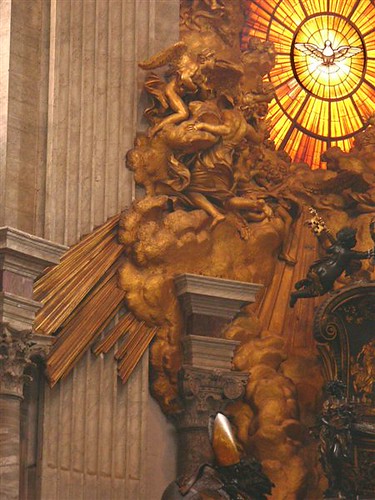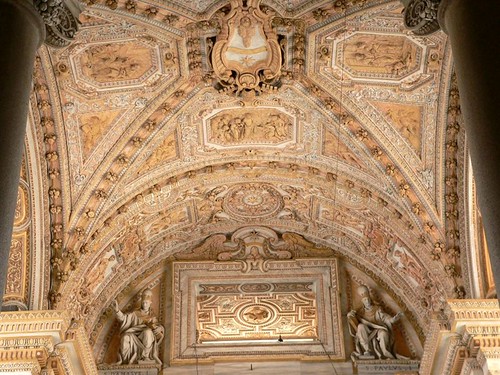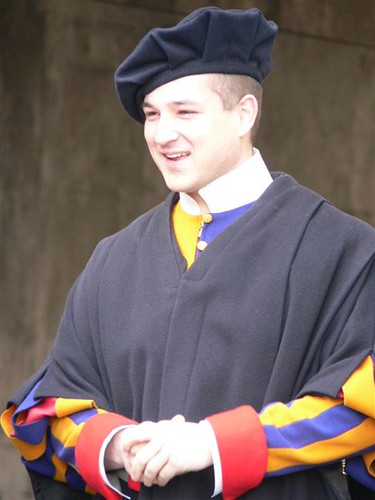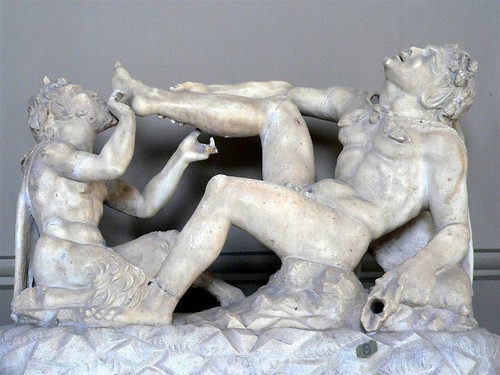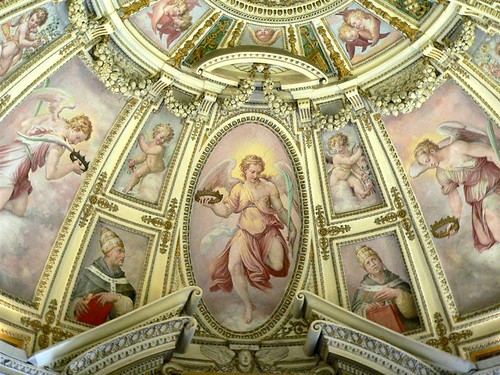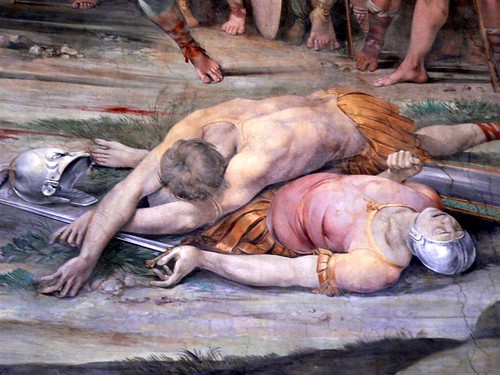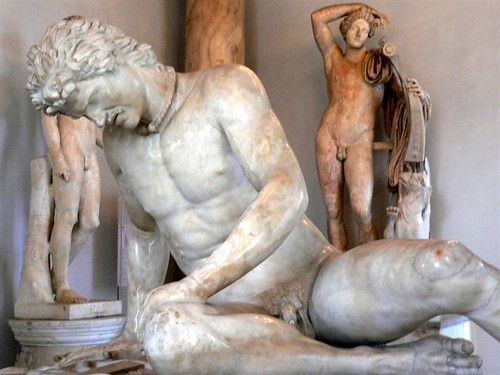
March 17, 2005: Tivoli - We got a wonderful start this morning heading for Tivoli and Hadrian's Villa. We were able to find the proper Autostrade straight away and arrived at the Villa by 9:30 a.m. We began by studying the meticulously detailed model of the Villa in the Visitor's Center.
Hadrian's Villa (Villa Hadriana) was built by the emperor Hadrian in the early second century CE. The villa was a sumptuous complex of over 30 buildings, covering an area of over 250 acres, of which much is still unexcavated.
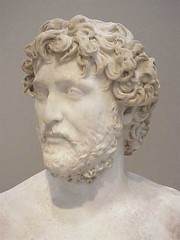
"The villa was Hadrian's preferred residence when he was in Rome. His choice of an imperial palace outside Rome, instead one of the several palaces in Rome, was probably influenced by the miserable relations he had with the senate and the local Roman aristocracy.
Hadrian was born in Spain, just like his predecessor Trajan, and the senate and the local aristocracy had trouble coming to terms with another provincial on the imperial throne.
The way Hadrian had assumed power only reinforced their opposition to him. Trajan's adoption of Hadrian on his deathbed was immediately cast in doubt, and when four military leaders, all Roman aristocrats who had been close to Trajan and hence possible contenders for the throne, were assassinated immediately after Trajan's death, the senate immediately suspected Hadrian of having ordered the killings.
Hadrian only arrived in Rome eleven months after Trajan's death, and denied any wrongdoing, but his relationship with the senate never recovered from the crisis. As a consequence Hadrian stayed very little in Rome. He travelled extensively throughout most of the emp
 ire in two prolonged periods, in 121-125 CE and in 128-134 CE, and when in Italy he preferred to stay away from Rome. A grandiose imperial palace outside Rome, but not too far away, was the perfect answer. René Seindal, Hadrian's Villa
ire in two prolonged periods, in 121-125 CE and in 128-134 CE, and when in Italy he preferred to stay away from Rome. A grandiose imperial palace outside Rome, but not too far away, was the perfect answer. René Seindal, Hadrian's VillaWe noticed a large group of people disembarking from a tour bus in the parking lot so we hurried to the Canopus, probably the most famous structure of the villa, so we could get some good photographs before the crowd arrived. Here's a wonderful Quicktime panorama of the Canopus!
The headless female warrior on the right is a Roman copy of a Greek sculpture of a wounded Amazon originally sculpted by Phidias for the Temple of Artemis.
Hadrian's Canopus is a recreation of the canal that connects Alexandria to the Nile in Egypt, and it was in these waters that the emperor's male lover, Antinous, drowned."
"Born in Bythnion around the year 105 of the Common Era, Antinous was a beautiful adolescent when he first caught the eye of the Emperor of the western world. Hadrian was already in his late forties by the time the two met; their sexual chemistry appears to have been mutual, eclectic, and immediate. Antinous became Hadrian's favorite, sharing the Emperor's bed and his
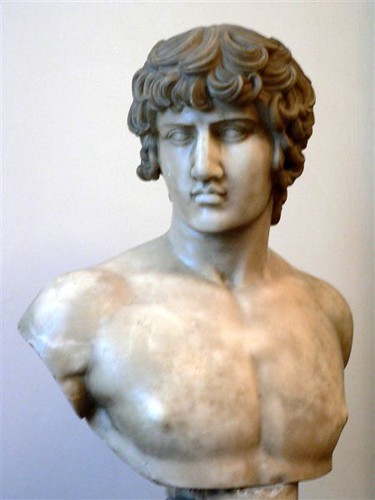 life. For a period of a little less than a decade, the two were inseparable, much to the disgrace of Hadrian's legal wife, the childless and spiteful Sabina. Imperial art and literature of the times show the men in a variety of guises and activities, particularly hunting: a sport the two enjoyed immensely.
life. For a period of a little less than a decade, the two were inseparable, much to the disgrace of Hadrian's legal wife, the childless and spiteful Sabina. Imperial art and literature of the times show the men in a variety of guises and activities, particularly hunting: a sport the two enjoyed immensely. In the course of their relationship, Antinous matured from a beautiful youth into an intelligent and well-muscled young man. The Greeks referred to the visible maturation of a youth (the growth of his beard and body hair) as "clouds hiding the sun." It was shortly after the Emperor's young lover had reached this stage of his development, and just after his hair had been cut short in the style favored by the mature men of the period, that Antinous drowned mysteriously in the Nile river during an Imperial visit to the province of Egypt.
Egyptian custom decreed that all drowning victims in the Nile automatically assumed a type of minor divinity, and so Antinous was proclaimed a God. Within a year, Hadrian returned to Rome, where he officially proclaimed Antinous as a Roman God. While still deeply mourning the loss of his beloved, the Emperor realized the political significance of the Greek youth's death, and from the tragedy forged a unifying cult of worship in the previously divided Greek city-states. Hadrian and Antinous together built a unified Greek nation, a feat which the warring city-states themselves had never achieved. Despite other great accomplishments as Emperor, Hadrian spent the last eight years of his life mourning Antinous." - The Story of Antinous and Hadrian
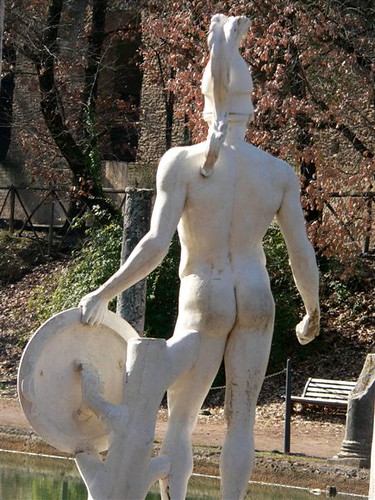
Ares, the god of war, presides over the remaining inhabitants of the Canopus. Both Pat and I thought he had a rather attractive "bum"! Along the right bank, a few carytids remain flanked by Silenus figures. The carytids are copies of the Korai from the Erechtheon on the Athenian Acropolis. It is thought these figures once supported a pergola possibly adorned with flowering vines.
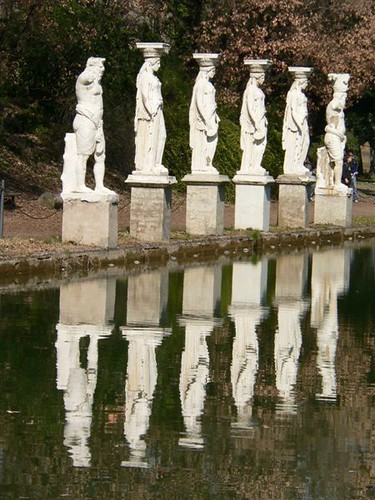
"Should any one wish for information on the origin of those draped matronal figures [...] called caryatids, I will explain it by the following story. Carya, a city of Peloponnese, joined the Persians in their war against the Greeks. These in return for the treachery, after having freed themselves by a most glorious victory from the intended Persian yoke, unanimously resolved to launch a war against the Caryans. Carya was taken and destroyed, its male population extinguished, and its matrons carried into slavery. To ensure that these circumstances might be better remembered, and the nature of the triumph perpetuated, the victors represented the matrons draped, and apparently suffering under the burden with which they were loaded, to expiate the crime of their native city. Thus, in their edifices, did the ancient architects, by the use of these statues, hand down to posterity a memorial of the crime of the Caryans."

I had hoped to see more mosaics as we wandered around the villa grounds but saw only remnants of the simpler black and white geometric mosaics that became popular during the first century CE. This floor once served as the surface for an exercise facility. Most of the colorful Hellenistic-style scenes created with polychrome tesserae have been removed to museums.
"In a hall in the Central Court of Hadrian's Villa a number of floor mosaics was discovered in 1779...two of mosaics illustrated country scenes with sanctuaries such as the "Goats with
 Goatherd". The wreathed figure in the mosaic is thought to be Dionysis since it holds a cluster of grapes and grasps a staff entwined with grape vines.
Goatherd". The wreathed figure in the mosaic is thought to be Dionysis since it holds a cluster of grapes and grasps a staff entwined with grape vines.Another pair of mosaics discovered at that time depicted a more brutal aspect of nature with scenes of conflict, one from 'ordinary' life showing a "lion attacking cattle".
Both mosaics share not only a rich polychromy but also certain stylistic features. To create the illusion of depth in the scene and
 volume in the figures, use has been made of shading, highlighting, three-quarter views, and foreshortening (especially the "Lion attacking Cattle".
volume in the figures, use has been made of shading, highlighting, three-quarter views, and foreshortening (especially the "Lion attacking Cattle".In "Goats and Goatherd", linear perspective is noticeable in the diminishing scale of the goats the further into the background they appear. Such naturalistic characteristics are generally associated with Greek painting from the 4th century BC onwards.
The mosaics are made in the polychrome tesselated technique, and were set into the floor as prefabricated emblemata. The area of Hadrian's Villa in which they were found belongs to its second building phase approx 128 A.D." - Mosaics From Hadrian's Villa, Classics New Zealand
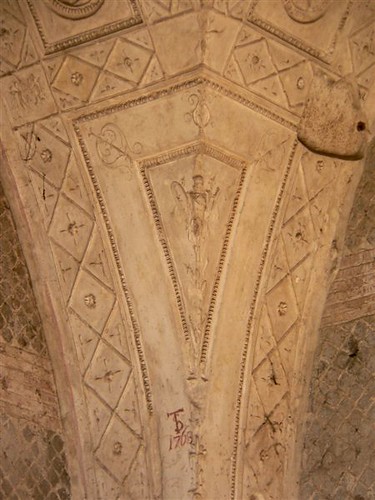 Of course the Opus, an Egyptian themed meditation pool flanked by Greek sculptures, is probably the highlight of anyone's visit to the villa but the remains of three large and small thermal bath complexes were also fascinating. These baths were fed by two streams that surrounded the villa as well as copius amounts of water from the surrounding hills. Tivoli's abundant water supplied four aqueducts for the city of Rome.
Of course the Opus, an Egyptian themed meditation pool flanked by Greek sculptures, is probably the highlight of anyone's visit to the villa but the remains of three large and small thermal bath complexes were also fascinating. These baths were fed by two streams that surrounded the villa as well as copius amounts of water from the surrounding hills. Tivoli's abundant water supplied four aqueducts for the city of Rome.Some of the vaulted ceiling still retained its decorated stucco.
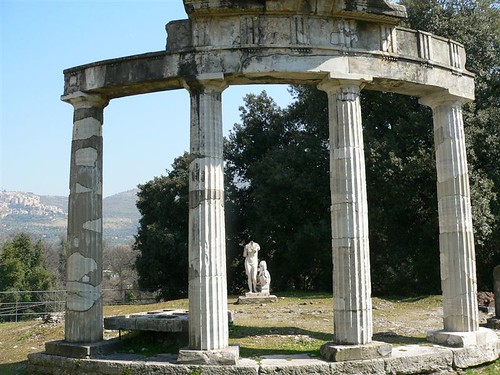
Hadrian also constructed a Temple to the goddess Venus built as a copy of the Greek tholos that guarded the sculptor Prassitele's original Aphrodite. Hadrian's "Venus" has been removed to a nearby museum and has been replaced by a cast of the original but I still found the remains of the temple soothing.
 Hadrian, ever the scholar, also built Greek and Latin libraries near a circular colonaded complex dubbed the Maritime Theater. It contains a mote-encircled miniature villa, complete with a small triclinium, sleeping rooms, and baths, that served as the emperor's private retreat. Hadrian reportedly loved to swim in the canal. The villa's island was connected to the outer grounds by revolving wooden bridges.
Hadrian, ever the scholar, also built Greek and Latin libraries near a circular colonaded complex dubbed the Maritime Theater. It contains a mote-encircled miniature villa, complete with a small triclinium, sleeping rooms, and baths, that served as the emperor's private retreat. Hadrian reportedly loved to swim in the canal. The villa's island was connected to the outer grounds by revolving wooden bridges.The Villa grounds are quite extensive and it took us until after lunch to take them all in. Richard suggested we still had time to visit Villa d'Este, a palatial estate built by a Renaissance cardinal. He showed me pictures of the spectacular fountains in a guide book we found at the gift shop at Hadrian's Villa. I readily agreed so we drove over there. As you all know, few things leave me speechless but V
"Villa d'Este, masterpiece of the Italian Garden, is included in the UNESCO world heritage list. With its impressive concentration of fountains, nymphs, grottoes, plays of water, and music, it constitutes a much-copied model for European gardens in the mannerist and baroque styles.
The garden is generally considered within the larger and altogether extraordinary-- context of Tivoli itself: its landscape, art and history which includes the important ruins of ancient villas such as the Villa Adriana, as well as a zone rich in caves and waterfalls displaying the unending battle between water and stone. The imposing constructions and the series of terraces above terraces bring to mind the hanging gardens of Babylon, one of the wonders of the ancient world. The addition of water-- including an aqueduct tunneling beneath the city -- evokes the engineering skill of the Romans themselves.
Cardinal Ippolito II d'Este, after the disappointment of a failed bid for the papacy, brought back to life here the splendor of the courts of Ferrara, Rome and Fontainebleau and revived the magnificence of Villa Adriana. Governor of Tivoli from 1550, he immediately nurtured the idea of realizing a garden in the hanging cliffs of the 'Valle gaudente', but it was only after 1560 that his architectural and iconographic program became clear-brainchild of the painter-architect-archeologist Pirro Ligorio and realized by court architect Alberto Galvani.
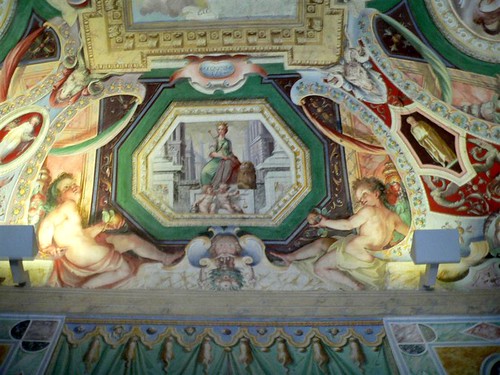 The rooms of the Palace were decorated under the tutelage of the stars of the late Roman Mannerism, such as Livio Agresti, Federico Zuccari, Durante Alberti, Girolamo Muziano, Cesare Nebbia and Antonio Tempesta.
The rooms of the Palace were decorated under the tutelage of the stars of the late Roman Mannerism, such as Livio Agresti, Federico Zuccari, Durante Alberti, Girolamo Muziano, Cesare Nebbia and Antonio Tempesta.
[Mannerism is described as "a self-conscious design, overcharged with rich, artificially "natural" detail in physically improbable juxtapositions of jarring scale changes." - Wikipedia]
The work was almost complete at the time of the Cardinal's death (1572)." - Villa d'Este Official Site
My friend and I thought it must have seemed a bit incongruous to some of Cardinal d'Este's visitors to see so many representations of Greek and Roman pagan mythology at the home of a prince of the Catholic Church.
Outside, the lush formal gardens spill over the hillside below the Villa like a botanical cascade blooming with sparkling fountains. The largest fountain includes a massive artificial waterfall that drops over four stories to a series of reflecting pools below it. If any man-made structure could ever be called paradise on earth, the Villa d'Este would have to be among the top contenders.
